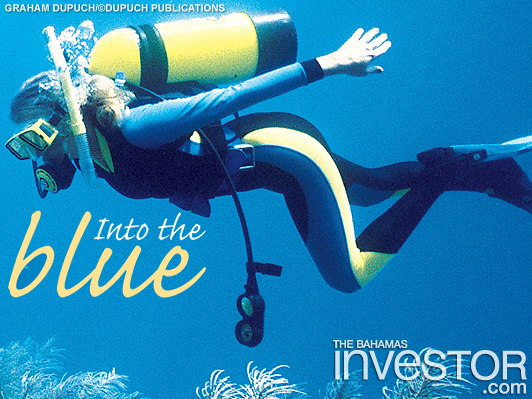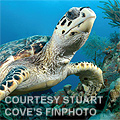| Published: Date: Updated: Author: |
The Bahamas Investor Magazine July 13, 2014 July 13, 2014 Catherine Morris |
Ask any diver why The Bahamas is consistently ranked as one of the world’s top diving locations and they will invariably tell you the same thing—it’s the water.
Conditions are perfect almost all year round, with balmy temperatures and crystal clear clarity underwater. Rainfall in the islands is absorbed by the archipelago’s limestone platform, which means there is virtually no run-off and the seas stay clear, helping the reefs to flourish and giving divers visibility of 80-150 ft. On days when the water is dead calm, that can increase to 150-200 ft.
“Visibility in The Bahamas is legendary,” says president of the Bahamas Diving Association, Neal Watson. “At 120 ft down you can see below you for another 100 ft. It is absolutely spectacular.”
When he relocated from the US to The Bahamas in 1965, Watson flew into Freeport and remembers marvelling at the view. “Looking down at the water, I could not believe it,” he says. “For a diver, that is paradise.”
Atlantean archipelago
The Bahamian island chain sits on a massive limestone bank, created by the deposit of sediment over thousands of years. With sea levels fluctuating over the generations and eroding parts of this porous base, many unique formations have been created, such as blue holes—deep sinkholes in the seabed—and intricate underwater cave systems.
The result is a Atlantean playground for divers. One of the biggest draws for experienced divers is the “wall dive” where the Bahamian shallows give way to deep underwater canyons, creating steep cliffs that plunge down into the depths.
Most divers agree that the best wall dive in The Bahamas is just off the coast of Andros, into the crevice known as the Tongue of the Ocean. Here the descent begins at 130 ft, and divers can see a variety of large pelagic fish, reef fish and corals.
Alexander McBarnet, senior trust manager at Rhone Trustees (Bahamas) Ltd and keen diver, has seen the wall and says it is a fascinating experience that is unique to The Bahamas.
“You would not get that in the Mediterranean,” he says. “The whole area is a fantastic playground for divers.”
McBarnet first learned to dive 11 years ago in Hawaii. “I was a little skeptical about it at first,” he says. “But from the first dive, I loved it.” He is now an active member of the Bahamas Dive Club, which meets monthly in addition to regular day trips and longer excursions, and tries to get into the water at least once a week.
Close encounters
Turtles, sharks, stingrays, dolphins, pelagic and tropical fish are just some of the creatures a diver can expect to encounter in Bahamian waters.
Bimini is the place to be if you want to see some diverse marine life, according to Watson. “If you want to see big animals, The Bahamas is your one-stop shop. For the diver who wants to interact with animals, plus get some incredible reef dives, you cannot beat Bimini.”
In Bimini, divers can greet wild dolphins face to face and mingle with sharks—including great hammerheads. These normally reclusive creatures congregate in Bimini waters, as do lemon sharks, nurse sharks and Caribbean reef sharks.
“Shark dives are enormous business for The Bahamas,” says Watson. “It is a great educational experience. Every person that does a shark dive comes out of the water with a new appreciation for these animals.”
In his dives, McBarnet has encountered several species of shark, and despite their fearsome reputations, he says that diving with them is “all part of the fun.”
“The sharks are not interested in us. We are a lot better off diving next to them than sitting above them on the surface.”
Night swimming
Aside from the notorious apex predators, McBarnet has run into lobsters, giant crabs and large sea turtles in his underwater explorations. He says the best time to get to know the underwater residents of The Bahamas is at night when you can get close to sleeping fish and see animals that are more active when the sun goes down.
“You see different marine life on a night dive,” he says. “You can see the fish sleeping in the reef and we tend to see more turtles at night. You can also see the ocean phosphorescence in the water. You turn off your torch, wave your hand and the water lights up with this white glow.
“Night dives are just a completely different sensation. In a day dive, you have a very long field of vision. On a night dive, you are in a very small world. It gives you a very different feeling.”
McBarnet also enjoys wreck dives and says The Bahamas is one of the best places in the world for this particular type of excursion. One of his favourite locations is the “Steel Forest,” which is a collection of three wrecks on the edge of the Tongue of the Ocean. Another favourite is a large DC-3 airplane, scuttled in 2004 for the film Into The Blue and left on the seabed. Movie props such as these are common debris on the ocean floors of The Bahamas, where the clarity of the water has long attracted Hollywood filmmakers. “It is quite fun to see all the props,” says McBarnet, who has dived remnants of the set from the James Bond film Thunderball. “There are so many wrecks here, it is incredible.”
Diving diversity
Over the past two decades, The Bahamas’ diving industry has grown by roughly six per cent each year. In 2012, the Bahamian waters welcomed more than 100,000 divers, netting the industry around $333 million. This has a knock-on effect for the entire tourism sector. Watson says: “A lot of people think of dive operations as little mom and pop operations, but most are owned by hotels or affiliated with hotels. We create enormous numbers of room nights, especially in the Family Islands. The dive industry is very critical for the success of Family Island hotels.”
Seeing more of the Family Islands is high on McBarnet’s diving wish list. A recent trip to Andros with the Bahamas Diving Club gave him the opportunity to explore several new sites including the AUTEC Buoy—an isolated buoy anchored in 6,000m of water used to orient US Navy submarines.
“It was right in the middle of the ocean,” he says. “There’s no land in sight. It was just blue and nothing else, so it is quite easy to go deep without realizing it. There are no reference points. It was fun … a very different dive.”
The diversity of dives available in The Bahamas is what makes it a standout destination, according to Watson, who says that the thousands of divers flocking to the country each year will never run out of options.
“People do not realize you can spend a lifetime of vacations and never repeat an island or a dive site in The Bahamas,” he says. “Each island has its own unique features. I have been diving here for almost 50 years and there are hundreds of places I haven’t been to yet. The Bahamas has, by far, the greatest diversity of marine life and dive experiences.”










